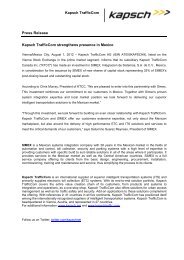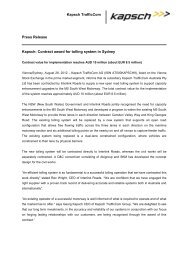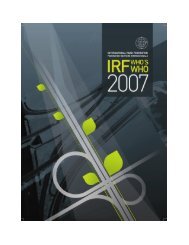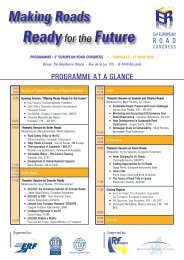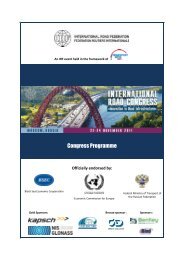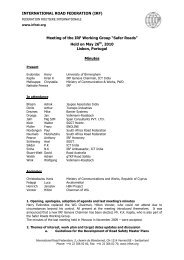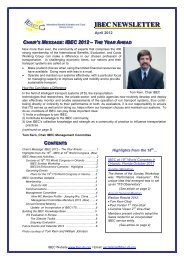Motorways and Urban Mobility - International Road Federation
Motorways and Urban Mobility - International Road Federation
Motorways and Urban Mobility - International Road Federation
You also want an ePaper? Increase the reach of your titles
YUMPU automatically turns print PDFs into web optimized ePapers that Google loves.
Bus Rapid Transit <strong>and</strong> <strong>Mobility</strong><br />
in Lagos Mega City<br />
Dr Charles Asenime<br />
School of Transport, Lagos State University,<br />
Ojo, Nigeria<br />
Introduction<br />
The Lagos metropolitan area, which has attained the status<br />
of a mega city, is by far the largest <strong>and</strong> most complex<br />
urban area in Nigeria. During the last two decades, levels<br />
of efficiency <strong>and</strong> productivity in the metropolitan area have<br />
been adversely affected by a serious <strong>and</strong> growing congestion<br />
problem. The increasing population of the metropolis has<br />
engendered an urban sprawl mostly made up of low-income<br />
workers who live at the periphery of the city. The situation is<br />
exacerbated by the poor condition of the road network, <strong>and</strong><br />
the absence of a functional traffic system architecture <strong>and</strong><br />
infrastructure.<br />
As part of ongoing efforts to improve the mobility of<br />
commuters <strong>and</strong> decongest the metropolis, therefore, the<br />
Lagos State Government selected some major arteries to<br />
be considered for the establishment of the first Bus Rapid<br />
Transit scheme in Africa. This became operational on 17<br />
March 2008.<br />
The Lagos BRT<br />
As seen in the preceding article, the Lagos BRT project is<br />
termed ‘Lite’ in so far as it does not seek to attain the highest<br />
specifications for such schemes, as found for example in the<br />
TransMilenio in Bogota. It is implemented under the auspices<br />
of the Lagos Metropolitan Area Transport Authority (LAMATA)<br />
<strong>and</strong> has two principal partners, the National Union of <strong>Road</strong><br />
Transport Workers (NURTW), which owns the Blue Buses, <strong>and</strong><br />
the Lagos Asset Management Company (LAGBUS), which<br />
operates the Red Buses. These two bodies were instrumental<br />
in contributing to the initial launch fleet of 180 high-capacity<br />
buses. These were used for the implementation of the first<br />
phase of the project, which covered the city’s Mile 12 to CMS<br />
traffic corridor, with the Red Buses running the route nonstop<br />
<strong>and</strong> the Blue Buses stopping at designated intermediary<br />
bus stops. Currently, the Blue <strong>and</strong> Red buses together make<br />
up a fleet of more than 1,200 vehicles.<br />
The BRT is 65% physically segregated <strong>and</strong> 20% delineated by<br />
road markings <strong>and</strong> distinctive pavement treatment. Lanes are<br />
typically 3.3m wide <strong>and</strong> are separated from other traffic by<br />
BUS RAPID TRANSIT<br />
Figure 1: The BRT Network (Courtesy: LAMATA)<br />
Plate 1: Segregated route way (Courtesy: LAMATA)<br />
concrete kerbs that are 400mm high. Gaps of approximately<br />
0.2m have been left in the kerbs to allow storm water to drain,<br />
thereby negating the need to reposition road drainage.<br />
Other features include well-built, distinctively marked<br />
stations, designed to enable level boarding <strong>and</strong> alighting<br />
(see Plate 2), as well as high-quality, attractive <strong>and</strong> functional<br />
amenities. The buses operate 16 hours daily (6am - 10pm).<br />
Impact indicators of BRT on mobility in Lagos<br />
Metropolis:<br />
• Low fares: The introduction of the BRT on the Mile12/<br />
CMS traffic corridor has reduced the cost of transport for<br />
low-income earners. Where they would have spent NGN<br />
300 (USD 2) previously, they now spend just NGN 100<br />
(USD 0.66).<br />
• Reduced travel time: The BRT has reduced commuting<br />
time drastically for those who use the service, especially<br />
during the morning <strong>and</strong> evening peak periods.<br />
• Increased comfort: With the BRT each passenger has a<br />
seat, unlike the molues (big yellow buses run by private<br />
operators) where four adults are often squeezed on a<br />
seat.<br />
• Orderliness: The BRT has introduced some order in<br />
passenger boarding, compared to the chaos <strong>and</strong> riots<br />
that frequently characterise the boarding of molues. In<br />
contrast, the average waiting time at bus stops for the<br />
yellow buses is 6 minutes, while waiting time at the BRT<br />
stations can be as high as 30 minutes (see Plate 3).<br />
IRF BULLETIN SPECIAL EDITION: URBAN MOBILITY |<br />
24






